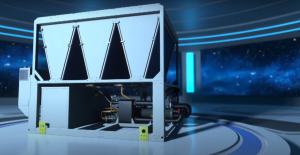As awareness towards the need to minimize the building sector’s impact on the environment is raising, Free cooling seems to offer an environmentally favorable approach which also helps saving on costs.
What is Free cooling?
For those who might be less familiar with the technology, with Free cooling we talk about the process of allowing a chiller to bypass mechanical cooling, using low external air temperatures to assist in chilling water, which then can be used for industrial processes or air conditioning systems. That essentially means that with Free cooling, when outdoor temperatures are favourable, chillers can turn off compressors and take advantage of the low outdoor temperature to chill water.
Free cooling types
Free cooling can be obtained in different ways and among the most popular there are Hydronic Free Cooling and then refrigerant migration Free Cooling.
Of course, those are both valuable options and they both have their place based on the specific requirements a project might have.
Hydronic Free cooling
Hydronic Free Cooling uses an additional coil or multi row coil using a water-glycol mixture as the free cooling medium. This module is typically attached to the chiller on the outside of the primary condenser coil, to cool the process fluid using low temperature ambient air.

In this case, instead of mechanical cooling with refrigerant circulating through the condenser coil, the building process water is run through the integrated free cooling coil, which exchanges heat with the outdoor air to achieve either full or partial cooling of the building load before returning it to the building.
This is a valuable solution for those applications that require full free cooling, namely those applications that require free cooling to recover the chiller’s full load.
Also, compared to other free cooling types, like the one using dry coolers, it is definitely more compact, and then it is an appealing solution for those sites where space is limited.
However, when not in free cooling mode, the integrated fluid coil can cause air-flow restriction across the primary condenser refrigerant coil and therefore a derating on the chiller’s performance. The impact on chiller efficiency can be significant (in the range of 10-15%).
Refrigerant migration Free cooling
Refrigerant migration Free cooling instead, takes advantage of the ability of specific refrigerants to move towards the coldest point in a refrigeration circuit.
 Essentially this Free cooling is based on a valve arrangement, which opens a direct path between the condenser and the evaporator. The relatively warm fluid in the chiller loop vaporizes the refrigerant, which then migrates to the condenser, where it is cooled and condensed again.
Essentially this Free cooling is based on a valve arrangement, which opens a direct path between the condenser and the evaporator. The relatively warm fluid in the chiller loop vaporizes the refrigerant, which then migrates to the condenser, where it is cooled and condensed again.
Also, the above-mentioned migration of the refrigerant can be assisted by a refrigerant pump or can take place naturally, thanks to the specific characteristics of the refrigerant – which is what happens with R-32 natural migration.
More on R-32-based natural migration-free cooling
R-32 refrigerant is known for the ability to naturally migrate to the condenser when certain conditions are met – hence the name of natural migration.
That is the way Daikin’s R-32 chillers with the patented Free Cooling option make free cooling happen. They use the R-32 ability to naturally migrate, with no assistance from any additional component like refrigerant pumps.
Daikin natural migration solution is glycol free on the water side, which ensures savings from a maintenance perspective, and also avoids any risk of contamination in process cooling applications.
Other than that, the natural migration-free cooling makes chillers even more compact than those using a Hydronic module or assisted refrigerant migration. That is because not only the Free cooling technology is directly integrated into the chiller, but also because there are no additional components like refrigerant pumps. This, of course, means a smaller and more compact footprint of the unit, but also translates into operative savings and maintenance-related savings.
The refrigerant migration, compared to Free cooling with the Hydronic module, can also be more efficient overall, as there is no air-flow restriction across the primary condenser refrigerant coil, therefore there is no derating on the chiller’s performance. There might be a downside to all this, though.
Natural migration Free cooling, contrary to what happens with the Hydronic module Free cooling, can only partially recover the chiller’s cooling load – Daikin’s R-32 Free cooling units can recover up to 75% of the chiller cooling capacity.
Application suitability
So, we essentially have a full Free cooling option with the Hydronic module on one side, and on the other side we have a partial Free cooling option, which ensures more compact footprint, more efficiency and potentially lower costs associated with maintenance.
Each of the options mentioned above have their place and their value depending on the requirements of specific HVAC projects.
Despite the slightly lower efficiency and the less compact footprint of the technology, it is clear that the Hydronic Free cooling option is a valuable solution for all those applications requiring full Free cooling. So, it is a good solution for those applications that need to recover the full cooling capacity of the chiller.
But what are the applications where partial Free cooling is a better-suited option?
Well, in this article, other than focusing on the benefits of partial free cooling based on natural migration, we will bring some examples of the applications that usually benefit from it.

Let’s think about Data Centers, for instance. Data centres typically operate 24/7, consuming vast amounts of energy and generating huge quantities of heat, which needs to be removed to guarantee the reliability of the service and the continuity of operations.
We know usually 35% of the energy consumptions generated by data centers come from cooling systems, that is why using efficient HVAC technology is absolutely important for these facilities. And that is also why Free cooling, in the right climatic conditions, is often required to make the data center as efficient as possible.
A Data Center, despite operating 24 hours a day, do not necessarily process the same amount of information across the day. That means there might be moments of the day, often at night, when the workload of the Data Center is reduced. That also reduces the need for cooling. In this case, natural migration Free cooling would be a smart and valuable solution, as the partial Free cooling would match a lower cooling demand from the data centre which is not operating at full capacity. In that case, partial Free cooling would definitely make sense, as it would be adequately sized to meet the cooling needs of the data centre at a specific time of the day, and it would also allow the data centre to benefit from overall better efficiency, easy installation and compact footprint if the space to accommodate the chillers is tight.
 The same applies to hospitals. HVAC systems in hospitals are usually responsible for almost half of the total energy used in the facility. That is why Free cooling, in the right climatic conditions, proves to be a valuable solution to increase the efficiency of the HVAC system and then the buildings’ overall efficiency.
The same applies to hospitals. HVAC systems in hospitals are usually responsible for almost half of the total energy used in the facility. That is why Free cooling, in the right climatic conditions, proves to be a valuable solution to increase the efficiency of the HVAC system and then the buildings’ overall efficiency.
Just like data centres, hospitals operate 24 hours a day, but that does not necessarily mean they need the same cooling load across the day. A hospital might reduce during the night the amount of activities that need cooling, as surgical rooms and test labs might not be operating at full workload. That would allow partial natural Free cooling to adequately match the cooling needs of the facility during the night and would also allow the hospital to benefit from overall better efficiency, easy installation and compact footprint if the space to accommodate the chillers is tight.
Do you want to know more about Daikin options for Free Cooling? Then, get in touch with the form below.
